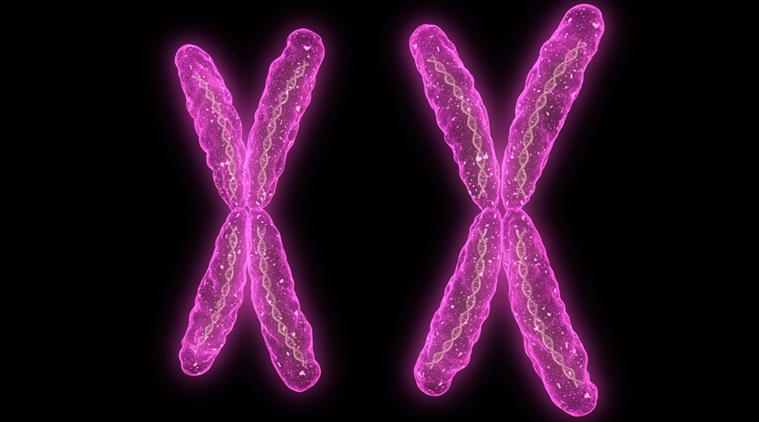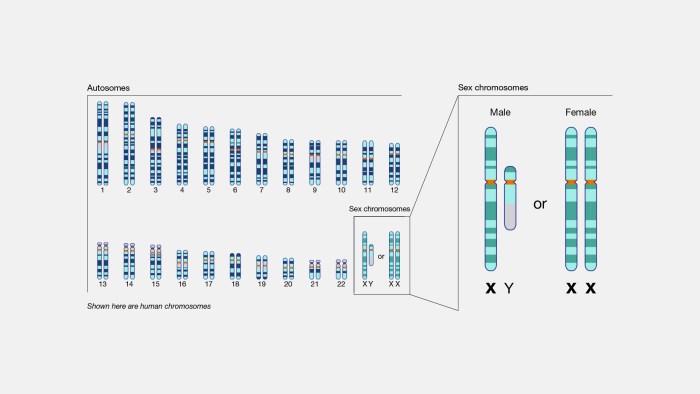X chromosome ap psychology definition explores the biological significance, genetic characteristics, comparative analysis with the Y chromosome, inactivation process, and clinical implications of the X chromosome. Delve into the fascinating world of genetics and psychology as we unravel the complexities of this essential genetic component.
The X chromosome plays a pivotal role in determining sex, carrying genes responsible for various traits and genetic disorders. Its unique genetic makeup and intricate mechanisms make it a captivating subject in the field of psychology.
Definition of the X Chromosome

The X chromosome is one of the two sex chromosomes in humans and other mammals. It is a large chromosome, containing approximately 1,098 genes. The X chromosome is essential for normal development and function in both males and females.
Biological Significance of the X Chromosome
The X chromosome contains genes that are essential for a variety of cellular processes, including cell division, growth, and development. It also contains genes that are involved in sex determination and sexual differentiation. In males, the X chromosome is inherited from the mother, while in females, it is inherited from both parents.
Role of the X Chromosome in Determining Sex, X chromosome ap psychology definition
The presence or absence of the X chromosome determines the sex of an individual. Individuals with two X chromosomes (XX) are female, while individuals with one X chromosome and one Y chromosome (XY) are male. The Y chromosome contains the gene for the male sex-determining factor, SRY, which triggers the development of male characteristics.
Genetic Characteristics of the X Chromosome
Size and Gene Content of the X Chromosome
The X chromosome is one of the largest chromosomes in the human genome, containing approximately 155 million base pairs of DNA. It contains approximately 1,098 genes, which account for about 5% of the total genes in the human genome.
X-Linked Genes and Inheritance Patterns
Many genes on the X chromosome are X-linked, meaning that they are located on the X chromosome and are inherited in a sex-linked manner. X-linked genes are passed from mothers to both sons and daughters, but only sons are affected by X-linked recessive disorders because they have only one X chromosome.
Genetic Disorders Caused by Mutations on the X Chromosome
Mutations on the X chromosome can lead to a variety of genetic disorders, including:
- Hemophilia A and B
- Duchenne muscular dystrophy
- Fragile X syndrome
- Rett syndrome
Comparative Analysis of X and Y Chromosomes

Structural and Genetic Features of the X and Y Chromosomes
| Feature | X Chromosome | Y Chromosome |
|---|---|---|
| Size | 155 million base pairs | 57 million base pairs |
| Gene Content | 1,098 genes | 78 genes |
| Sex Determination | Female (XX) | Male (XY) |
| Inactivation | One X chromosome is inactivated in females | No inactivation |
Evolutionary Relationship Between the X and Y Chromosomes
The X and Y chromosomes are thought to have evolved from a pair of homologous chromosomes. Over time, the Y chromosome has lost most of its genes, leaving only a few genes that are essential for male development and fertility.
X Chromosome Inactivation

Process of X Chromosome Inactivation
In female mammals, one of the two X chromosomes is inactivated in each cell. This process, known as X chromosome inactivation, occurs early in embryonic development and is random, meaning that either the maternal or paternal X chromosome can be inactivated.
Role of the Barr Body in X Chromosome Inactivation
The inactivated X chromosome forms a condensed structure called a Barr body. The Barr body is visible in the nucleus of female cells and is used to determine the sex of an individual.
Implications of X Chromosome Inactivation for Gene Expression
X chromosome inactivation has important implications for gene expression. Because only one X chromosome is active in each cell, females are mosaics for X-linked genes. This means that they have two copies of each X-linked gene, but only one copy is expressed in each cell.
Clinical Significance of the X Chromosome

Genetic Disorders Associated with Abnormalities of the X Chromosome
Abnormalities of the X chromosome can lead to a variety of genetic disorders, including:
- Turner syndrome (monosomy X)
- Klinefelter syndrome (XXY)
- Triple X syndrome (XXX)
- XYY syndrome
Use of X Chromosome Analysis in Genetic Counseling and Prenatal Diagnosis
X chromosome analysis is used in genetic counseling and prenatal diagnosis to identify individuals who are at risk for X-linked disorders. This information can be used to help families make informed decisions about their reproductive options.
FAQ Explained: X Chromosome Ap Psychology Definition
What is the X chromosome?
The X chromosome is one of the two sex chromosomes found in humans and other mammals. It is responsible for determining the sex of an individual and carries genes for various traits and genetic disorders.
What is the role of the X chromosome in sex determination?
In humans, females have two X chromosomes (XX), while males have one X chromosome and one Y chromosome (XY). The presence or absence of the Y chromosome determines the sex of the individual.
What are X-linked genes?
X-linked genes are genes located on the X chromosome. Males have only one copy of each X-linked gene, while females have two copies. This can lead to different patterns of inheritance for X-linked traits and disorders.